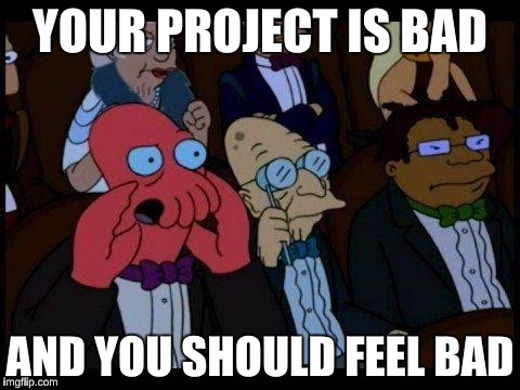Continuous: past, present, future
Building and testing GNOME, one commit at a time
GUADEC 2017 | Manchester | Emmanuele Bassi <ebassi@gnome.org>
Welcome!
Hello, everyone, and welcome to GUADEC!
If you are reading this, though, welcome to the notes to my GUADEC 2017 talk.

Hi, my name is Emmanuele Bassi. You may remember me from such presentations as "All my Clutter state of the unions", or "An history of how GTK draws", or "The GTK scene graph that will be ready next year I promise".
What is "Continuous"?
This time, though, I'm here to talk to you about building GNOME, and what is "Continuous".

A bit of history.
"Continuous" started as a spin off from the "GNOME OS" idea, as a way to generate an operating system image that the GNOME design team could download, install, and run in order to test changes that landed in Git.
Before Continuous appeared, the design team had to deal with JHBuild, which was never really reliable for a day-to-day development of the whole of GNOME.
Colin Walters created Continuous using OSTree in order to make it easy to upgrade an installed OS, and avoid downloading VM images from the GNOME infrastructure. It also allowed to go back and forth between different builds, at different points in time, thus making QA easier.
"GNOME Continuous" is a continuous integration and delivery platform that builds a well-defined set of components that we call "GNOME" and deploys the result into an OSTree repository
Let's start with a definition. We are going to go through each part of it, so that by the end we're going to understand what "Continuous" means and what it does for GNOME.
Wait, what is
Continuous Integration?
«In software engineering, continuous integration (CI) is the practice of merging all developer working copies to a shared mainline several times a day.» — Wikipedia: Continuous integration
Thanks to Wikipedia, we have a somewhat shared definition of what "CI" means.
You build everything against a known base, with known tools, and check that not only a commit, or a branch, or a tag go through the build step without issues, but also that the test suite works.
You can run CI for each module inside a complex project, like GNOME, assuming you have a shared base environment you don't need to constantly build as a base. CI is what tells you that the commit you just pushed, or the branch you just merged, broke your own project.
Wait, what is
Continuous Delivery?
«Continuous delivery (CD) is a software engineering approach in which teams produce software in short cycles, ensuring that the software can be reliably released at any time.» — Wikipedia: Continuous delivery.
Again, thanks Wikipedia.
In more prosaic terms, it's a way to take all the resources that make a project, deploy them at a "staging" location, and run the tests. If you manage to do this quickly enough, and under enouhg automation, then what you call "a release" is just the promotion of a build on a staging location to a production one.
This has the additional benefit that it should remove the need for fixes done directly in production; just fix on the main line, drop into staging, run the tests, and promote to production.
CD is what tells you that the commit some project pushed, or the branch some project merged, broke everything else.
Wait, what is a
Continuous integration and delivery pipeline?
Combining CI and CD into a single pipeline is what makes it possible to build and test complex projects, like GNOME.
We cannot build each module in GNOME as a separate, independent entity; each module has dependencies that GNOME itself provides.
We need CI to build every project inside GNOME.
We need CD to ensure that all of GNOME gets built in a well-known sequence.
Additionally, tests for each module should run inside a well defined environment, as they can interact and may require things like a session, or ancillary utilities. Your option is to create a mock environment separate for each one of them, and then hope the mock environment reacts as the real one; or to run all the tests in an environment close enough to the real one because it is the real one, even if it runs on a VM.
Who is CI/CD for?
- Maintainers / Contributors
- Downstream packagers / OSVs
- Application developers
- QA
Maintainers use CI/CD to verify that their project builds in various configurations, and that any release or commit does not prevent the rest of the GNOME project from running.
Contributors use CI/CD to verify that the changes they are creating do not break existing uses.
Downstream packagers use CI/CD to have a known to be working baseline against which they can test their own patches and integration.
OS vendors use CI/CD as the baseline for a minimum viable product based on GNOME.
Application developers use CI/CD to have access to the platform API that GNOME provides, and eventually influence its direction.
Quality Assurance use CI/CD to have access to the current build and verify the localisation, help, and behaviour are the expected ones.

What does it all mean?
Continuous builds GNOME from source and tests it
In so far as saying that "GNOME" is a collection of projects, each made of code, documentation, data, and tests; and all projects interacts with each other in order to create an operating system as well as a desktop environment; and that the OS and desktop environment provide an agreed upon API for application developers to run their applications...
Continuous is GNOME
Then Continuous is GNOME.
Hi, my name is Emmanuele and I'll be your build sheriff for today

Build sheriff: an individual, or more commonly a group of individuals, monitoring the state of the builder looking for broken builds and/or tests
Build sheriffs, pictured here in their natural habitat.
A group of individuals (almost) constantly monitoring the continuous build pipeline, looking for broken builds and/or tests. These individuals are known as "build sheriffs". The sheriffs' role is to "keep the build green", or in other words, to keep the code in our respositories in a good state, to the extent that the state is reflected in the output shown on build.gnome.org.

Many think that build sheriffs are ogres, waiting for a build to fail to chastise the poor committer who didn't have any idea that the commit they pushed to git.gnome.org could break the build for everybody else.
Sheriffs are your best friends
Of course we are not ogres. Checking that things build is what CI is for.
When sheriffs see a build or test has been broken, they are empowered to take one of several actions, including pushing a fix; reverting the commit that caused the problem; or tagging a repository to a specific commit until the maintainer fixes the issue.
A build sheriff is the person that will tell you that the latest commit in a dependency broke a module that depends on your project; or that a deprecation in a base dependency is now in effect, and that you should either disable deprecation errors, or fix your code; or that a new version of the compiler enabled a new warning, and thus your code is now failing to build.
All of this happens on a neutral base, with complete logs and a known configuration, so you know where to look, how to reproduce, and possibly what to fix.
From great power comes
great responsibility
Build sheriffs have a very important role in any complex project. They do not act as gatekeepers, but they ought to be the ultimate arbiter of what stays into the code repository. What we do, as a free and open source software project, does not amount to dumping code that may or may not build in the lap of anybody with a network connection capable of cloning a series of repositories and downloading a bunch of tarballs.
We provide people with a working set of interoperating components, and those components must always build, and at the very least result in something that can be run. Pushing randomly broken things to the master branch is not acceptable; that's what topic branches are for.
From no power comes
all the responsibility
— Emmanuele Bassi
I've been in the not really enviable position, for the past two years, of working as the unofficial build sheriff. All the responsibility, with none of the power.
What did I learn?
Aside from badly quoting comic book characters, acting as a build sheriff was a way for me to learn about software development and engineering best practices; reliability; quality assurance; testing; integration and delivery.
Of course, the real things I learned were slightly different.
- Nobody builds their code
- Choice is broken
- RESOLVED WORKSFORME
But, it mostly taught me that nobody ever compiles their own code.
Additionally, that every single maintainer who offers a build-time configuration choice does not test them after they get merged.
Most definitely, that the common process to write free software amounts to: "Does it build on my laptop with a dirty build tree? If it does, then ship it".
The real treasure was
the hatred we found
along the way
As it turns out, I hate all software developers.
I'm an equal opportunity hater.

«You will never find a more wretched hive of scum and villainy. We must be cautious»
Mos Eisley, or: the stereotypical free and open source software project.
Hate, for lack of a better word, is good
This is the Gordon Gekko moment of the talk.
Software, far from being a rational effort, is profoundly based on emotion.
Positive emotions are a great thing, and that we all strive to have something excellent and exciting for everyone else to see, use, and contribute towards.
As a matter of fact, though, I find disappointment a powerful motivator to get stuff done, when it comes to fixing broken behaviour. I enjoy the moment when something goes from not working to working, and that includes every step of the way: from broken design, to broken architecture, to broken implementation, to broken testing, to broken integration.
This motivation is part of why I contribute to GNOME; there are very, very few free and open source projects that actively encourage contributors to own up broken components, architectures, and design. Being a GNOME contributor means taking responsibility for something broken, fixing it at the best of your abilities, and then contribute it back to the larger community.
It's the campsite rule — "leave the project in a better state than when you found it" — applied to free software.

Of course, I realise that this may be my thing, so your mileage may vary.
Lots of things to do
Turns out that working in free software has left me with no shortage of broken things I can complain about on social media and on IRC, and possibly fix if I have push access to the Git repository.
For any given day, in truth, there are more broken things than working ones.
Free software is full of poorly thought through components that barely work in isolation, let alone together, and it's entirely up to us to see them all as a cohesive unit, and fix them.
Let's talk about building GNOME
Building GNOME is not a trivial matter.
GNOME requires a core set of functionality provided by the underlying kernel and basic user space in order to even build, let alone run.
On top of that, GNOME is composed by many, many, many components, often interoperating through API; ABI; introspection ABI; and IPC ABI.
In the past few months we had various cases where a CI/CD pipeline helped us track down changes all across the board, both originating from a module, and across various components.
Case study 1: GLib tools
GLib provides a few tools that deal with code generation for some of the boilerplate needed to write GObject. These tools are widely used in GNOME, and have existed since the early days of the platform, back when GLib was new and the world full of possibilities and wide-eyed idealists writing a desktop environment by first principles. This also means that a lot of the build infrastructure and code relying on them is old, and generally poorly understood. A constant of the software community is cargo culting our way out of a pickle, and before the advent of Stack Overflow, free software relied on simply having access to the code of various projects in order to not spend time understanding the tools at our disposal.
Any change made to one of the tools provided by GLib has the potential for a knock-down effect on any project that directly, or indirectly, depends on them.
Of course, we need to understand that none of the behaviours are actually specified, documented, or tested locally; so the only way to check whether a change has broken something is, quite literally, to rebuild the whole of GNOME and hunt down the breakage.
This cannot be achieved on a GLib maintainer's laptop, for reasons of time, combinatorial explosion of dependencies, and complexity of the build matrix. This is where a service like a continuous integration pipeline is fundamental in order to have a good idea of whether a change can be done, or whether it should wait.
Case study 2: Meson
Meson is a new build system that is getting increasing adoption in the GNOME community, as a replacement for Autotools.
Building applications with Meson is easy, and I thoroughly recommend switching to it.
Libraries, though, have an API and an ABI, and projects that depend on them. Changing the build system in a platform library may end up breaking a direct dependency because of missing symbols, or a different soname than expected.
Again, this is not something that can be directly caught with a test suite inside the project itself.
Typically, this kind of breakage is caught by Linux distributions, but not every library ships to Linux platforms only; and the development cycle of Linux distributions is not generally synchronised with upstream development.
We're also trying really hard to decouple GNOME from the underlying OS in order to let distributors and application developers not having to care about the environment outside of GNOME. This means taking up some of the responsibilities that have been, historically, the remit of packagers.
Decentralisation, composition, delegation
As a community, we consciously end up splitting off components instead of centralising functionality; we prefer delegation and composition to piling API inside single points of failure.
We like small components because we value the design philosophy that allows us to provide choice to our users, and the ability to compose an OS tailored to their needs, via loosely connected interfaces.

This is, of course, a complete and utter fabrication.
We like smaller components because it makes it easier for each maintainer to keep stuff in their head without going stark raving mad; or it makes it easier to insulate, or route around, maintainers with strong opinions with which we don't really agree; or to drop dependencies when they inevitably become unmaintained; or to avoid thinking about a specific niche job or area that we don't know very well.
"Choice" is a side effect, mostly unintented and definitely not welcome, of this process.
Complexity breaks choice
No: Linux is not about choice.
Every complex system that worked invariably evolved from a simple system that worked.
A complex system designed from scratch never works and cannot be made to work.
Additionally, the more complex you make a system, the more unlikely you can make it work in all its configurations. Only a small subset of interactions can be built, tested, and verified as working.
If you're not testing a configuration, you must assume it's broken.

Shipping broken stuff is bad for users, because they will end up with a broken tool that does not help them achieve their goal, and if they can't do the things they set out doing, they will not use what we create.
Shipping broken stuff is bad for maintainers, because people will file bugs, and maintainers get to fix them, and the time you spend tracking down and fixing bugs prevents you from writing features, which are cool and rewarding for the time you put into your project.
Shipping broken stuff is bad for downstream packagers and OSVs, because they will be placed in the position of not being able to integrate the bad software you just released, and will file bugs — and while you can trick people with "it works for me" for a while, you can't do that forever.
A maintainer has a problem, and they think
"I'll add some unit tests!"

Unless you're working on a single project, with very few dependencies, and basically no users, unit testing won't solve anybody's issues.
Integration testing is much more complicated, and it usually comes at a fairly high cost. You need to set up a way to build your project, and all its dependencies; then you need to set up an environment in which you can run your unit tests. Then you need to ensure that you build and run the tests every single time you, and possibly your direct dependencies, commit a change. This is usually slower than running make check, and if I learned anything in the past decade of free software contributions is that maintainers have issues doing that already.
Integration testing is a spectrum, of course; if you build two libraries inside your project, you can check the integration of the two by simply writing a local unit test that exercises the combination of the API. If your project provides two separate services, you could write a unit that connects to both of them.
We favour small, separate components; this means that there is spatial and temporal distance between them. Project A can change between commits of project B, and vice versa. This means you need something that checks both project A and B.

Stop shipping broken software
Summing up.
If your project does not build unless it's your laptop…
If your project does not build unless it's packaged for your Linux distribution…
If you don't know if a change you committed will break something else outside your test suite…
If you don't have a test suite running every time you commit something…
Then you are shipping broken software.
Stop doing that.
Continuous Integration/Delivery
This is what Continuous Integration and Delivery is.
Continuous Integration
+
GNOME
Building GNOME is really building a lot of projects, in a well defined sequence, and making sure everything comes out all right at the othen end.
Without automating this process, the continuous integration for the whole of the project would be a distributed mechanism also known as "humans over the Internet". We can, and we did, inflict this pain on our contributors, but I'd argue that unnecessary pain is not really fun, and, more importantly, it does not scale.
Consider, if you will, how much better is the situation since we had Continuous, when running jhbuild. The amount of breakage went from a daily occurence to a random breakage introduced by system dependencies.
These days we not only have Continuous running the full build; we also have Flathub running the GNOME SDK build, mostly from the same sources and using a fairly similar environment.
Continuous Integration
+
GNOME
=
♥
This is what happens every day, seven days a week, 365 days a year. It's not always obvious, and you generally notice only if something breaks.
You'll notice breakages because somebody will notify you on IRC, or file a bug, saying that your project fails to build on Continuous.
You may notice it faster if you're on the #testable or #gnome-hackers IRC channels.
We're still far away from something that is up to par, though.
The current state of the art for CI pipelines in the commercial and free software world are:
- Travis, free for open source software, takes care of Linux and macOS (when it's not down)
- AppVeyor, free for open source, takes care of Windows
- GitLab, soon to the GNOME infrastructure nearest to you
All three are generally based on a script that describes the build pipeline. All of them are good enough for building your app on a set of dependencies that are generally assumed not to change.
As we've seen, this is really not the case when it comes to building and testing GNOME.
Ad hoc solutions
are best solutions
Continuous is, currently, a JS tool that consumes a JSON manifest that lists all the components it needs to build, in the order in which they must be built.
The overall idea is similar to how flatpak-builder works: you build all the components into a reliable, separate sandbox, with the artifacts of the build accessible as the base system; no network connection; and no additional privileges. At the end, you get a file system image.
In order to bootstrap this entire process, Continuous uses a Yocto base system, containing things like binutils, the compiler suite, and other components that are hard to build from source without a ton of patches.
The Yocto base is there not just because of political concerns — we don't want to play favourites; but also because it's useful to have a neutral vendor as a target. It keeps us honest, and gives OS vendors a baseline to follow.
After each build, Continuous takes the artefacts and pushes them into an OSTree repository. This de-duplicates the identical files, and allows us to have a full history of the build. The size of the OSTree repo for Continuous after 5 years of daily builds is ~570 GB.
After each build, Continuous builds a VM image; boots it up; checks that we reach specific checkpoints in the boot process (smoketesting); and runs a series of tests (installed by each component) inside that VM. Then it spins down the VM, and puts it up for download if successful.
Where do we go from here?
Of course, this custom set up has a series of issues that have become more and more apparent over the years.
The JS code base is not really what I'd call "easily accessible"; this is one of the reasons why it hasn't changed very much in the past 5 years.
The JSON manifest is too easily broken, and at the same time not expressive enough. Ideally, the Flatpak builder manifest format would help us, but it would not be a 1:1 match with our requirements in any case.
Additionally, it has integration issues with the underlying OS; for instance the VM image build has stopped working in March, after an upgrade that involved SELinux and FUSE. Debugging this has proven fairly hard, and not many people understand the intricacies of this whole system.
The integration with Git is flimsy; the daemon gets often stuck, and it does not run on a commit hook to avoid DoS'ing the whole GNOME infrastructure.
The build bot is heavily tied to the concept of a Build API (a subset of Autotools) which puts it at odds with the overall effort to move to Meson, unless we patch every single module not using Autotools.
Work in progress
Still, there is an effort to make this whole thing work better.
Switching away from an ad hoc JS script to a series of steps in a pipeline, using Buildbot as a base, like Flathub does, would increase the reliability of the process.
Getting help from the libvirt and qemu developers to ensure that we can always build VMs for smoketesting and QA.
Improving the notification system to tell maintainers when a build breaks; automate "fails to build" bugs; add tracking branches; add nightly builds for stable branches as well as continuous builds for master.
Adding more people to the pool of build sheriffs, to increase coverage outside of the European timezones.
Ensuring that applications are placed under Continuous Integration separately, using the GNOME SDK nightly builds as a base.
Adding more tests for the system components, to track regressions.
Keep building
More importantly, though, we need every GNOME maintainer and contributor to follow the mindset that it's our responsibility to keep GNOME building and working, and that the world does not stop at our laptop; at our Git repo; at our project; or even at our distribution.
Ensuring that GNOME, as a larger ecosystem, is seen as a reliable partner improves not just our standing in the free software world, but it makes our job easier.
Continuous is not just a way to enforce good engineering practices; it is outreach.
Keep making GNOME awesome
In the end, we are all in this together, to create a strong and stable environment for our users.
Our goal is not to build GNOME: it is to empower our users to achieve what they want to achieve, with as much support from their hardware platform as possible; with as much security and privacy we can offer; with as much flexibility we can reliably support.

I'd like to thank my employer, Endless, for letting me talk at GUADEC in front of all of you, wonderful people.
If you're reading this notes, on the other hand, thanks for checking out my talk, and I'm sure you're wonderful as well.
Thank you!
- License: CC by-sa 4.0
- IRC: #testable on irc.gnome.org
- Source: https://github.com/ebassi/2017-guadec
- Slides: https://ebassi.github.io/2017-guadec
- Blog: https://www.bassi.io
- Job: https://endlessm.com
Image credit: CC by-sa 4.0 except:
- endless.png: Copyright Endless Global, used under Fair Use
- double-rainbow.jpg: CC by-2.0, Tatiana12, https://www.flickr.com/photos/98826299@N00/29039049002/
- lying-cat.jpg: Copyright Brian K. Vaughan and Fiona Staples, used under Fair Use
- no-integration-test.jpg: Unknown, used under Fair Use
- ogre.png: Copyright Apple, used under Fair Use
- scum-and-villainy.jpg: Copyright George Lucas, used under Fair Use
- troy.jpg: Copyright Matt Groening, used under Fair Use